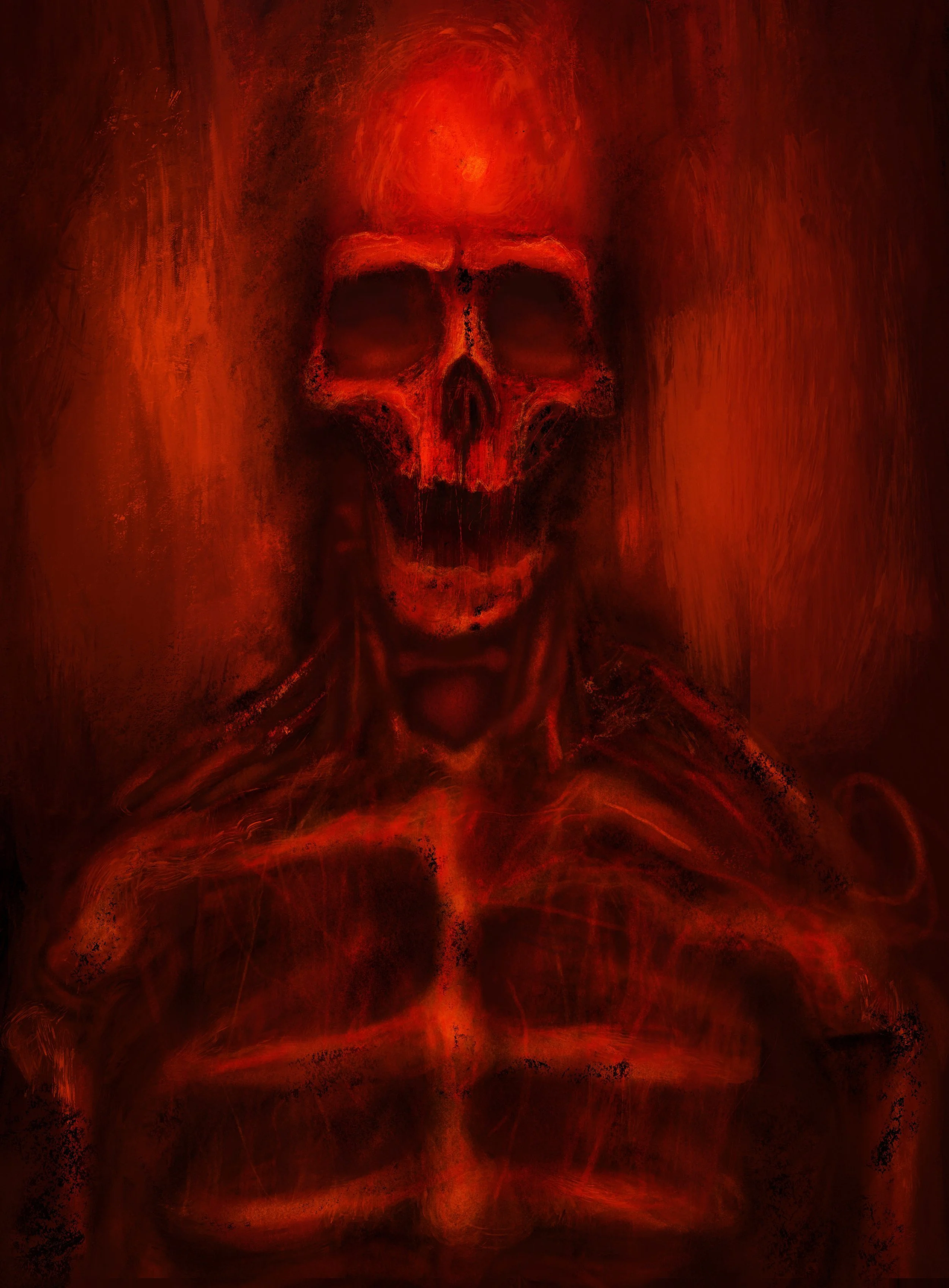Know No Truth: The Work of Landon Richmond
Boston-based artist Landon Richmond is best known for his painted art from his website and gallery, “Know No Truth,” and has a unique style that could be described as a blend of Salvador Dali, Tim Burton, and Marilyn Manson. This fascinating work focuses on darker aspects of life, whether that's depicting famous horror icons, omens of evil transmitted, or just the macabre.
As mentioned on his website, “Landon Richmond was born in the jungles of Florida, where he spent much of his youth fighting tigers, cyborgs, and dinosaurs. It was during those years of endless battle that Landon picked up a love of painting. His love of painting made him put down the spear, and pick up the brush.” While this may cover the “No truth” aspect of his biography, the rest is the “know truth.”
Richmond’s work is not for the faint of heart, as his work can be dark and mystifying, yet hard not to stare at. “It’s dark surrealism… It’s dark on the forefront. Those elements of darkness tell a broader story, connecting abstract thought to the more concrete reality we live in. That’s the goal of surrealism,” Richmond said.
“In this Sea Full of Hooks” Photo courtesy of Know No Truth
Richmond mentioned that he views the world as an indifferent and meaningless place, emphasizing that is up to us to find our own meaning. “Because we have a meaningless, indifferent universe, that means that it's our goal in life, our purpose to create our own meaning and find our own path. For some, it might be a craft, it might be a person or family, for some it's religion.”
Despite his focus on the grim and the morbid, Richmond considers his work as being “true” and reflects authenticity rather than superficiality. “People used to tell me my art was dark when I first hit the scene and I didn't know what they meant. To me, it was just normal and obvious stuff,” Richmond said. “I feel my art is very much about being true.”
Landon eventually described himself as an eccentric and occasionally difficult child. Like many children and teenagers who grew up to be artists, he wasn’t immediately understood by everyone. It was 80’s slasher horror films that made him interested in the macabre.
“The first thing I drew was of Godzilla destroying a city and rivers of blood, which was very concerning to every adult in my vicinity,” Richmond said. “I was quickly drawn to horror movies even though I wasn’t allowed to watch them as a little kid. I would go to the supermarket, and there was a monthly horror magazine…I would look at those pictures and imagine in my head what those movies were about, which was usually more twisted than the movies themselves.”
While his family has been supportive of his career in art after proving that he could support himself, they don’t fully get his work. Despite this, his family taught him how to run a business.
“My brother just thinks I just paint skulls all day. My parents also didn’t get my art, but I didn’t need them to get my art. What I needed was help understanding how to run a business because I had no experience in that,” Landon said. “I was a good salesperson, but the more nitty-gritty aspects of business decisions weren’t something that I had hardwired into me. I was incredibly lucky to have a business-oriented family to help guide me to a functioning system. It doesn’t matter how much something sells if you can’t manage the money.”
Landon further explained that his art isn’t for everyone, and it wasn’t meant to be understood by all people. His work may be dark, but it may also shed light on true feelings that are felt by most people.
“If everyone understands you, then you’re not doing it right… By default, we do what makes us comfortable. I think what’s really important is knowing when to make ourselves uncomfortable. Sometimes we avoid doing what we’re needed to do because challenge is uncomfortable,” Landon said. “Other times, it’s important to be comfortable because that’s when you get your best results… You have to pick and choose.”
“The Red Queen's Victory” Photo courtesy of Know No Truth
While much of his work is open to interpretation, many would likely agree that his work is unapologetically “him.” Richmond also mentioned the importance of being true to oneself. According to Richmond, “You always have to be yourself, and I know that can be very hard. It’s also easy to be yourself while still not entirely knowing who you are. It’s when you don’t suppress yourself… You don’t tone yourself down out of fear of rejection.”
Before finding success in the world of art, Landon dropped out of college and initially sold art on the street in Boston.
“I was there for eight hours, and I didn’t sell a single thing… and to me it was so crushing. I felt like quitting,” Richmond said. “Right when I was about to pack up, this guy that I barely knew walked by and said, ‘Oh my gosh, I love this. I need to buy one of these.’ And I sold one piece, which may not sound like a lot, but it blew my mind…all it took was that one sale.”
The following day was a similar situation of not selling anything for nearly eight hours. He once again considered quitting. “The same thing happened...I thought that the customer from the day before only bought from me because he felt bad for me and wanted to make me feel better,” Landon said. “I was once again about to pack up and go home, then I heard someone call my work ‘awesome.’ This was someone I didn’t know at all who bought one of my pieces, and then I knew I could do it.
Landon returned the following weekend and sold about 30 pieces of art, leading him to sell in more than just one area. “As my confidence in myself grew, so did the support in my work. I started hiring college students to sell my work on sidewalks all around Boston, and it kind of became this underground thing that started its own art movement with other artists joining along.”
This success led Richmond to open pop-up galleries and kiosks in shopping malls. He eventually opened a gallery on the same street where he first sold his work about a decade later. This was all good until there was an electric problem that caused a major fire in his gallery.
“This was a roaring Inferno with smoke so thick, you couldn’t see past your elbow. I didn’t want to abandon my art, so I kept trying to put out the fire before I realized if I didn’t leave this building, I was going to burn. When I evacuated that building, my hair was white from all the ash.
While the property was insured, much of his art was lost, adding even more emotional pain to this experience. “What do you do when you watch your dreams literally burn down? For me, that was just rebuild,” he said.
Landon eventually opened an art gallery in Sarasota, FL, and transitioned to mostly selling work online and at arts and crafts shows. Despite having found continued success, he still plans to open another gallery in Salem, MA, when “the time is right, as well as the location.”
“A Slow Beautiful Disintegration” Photo courtesy of Know No Truth
Richmond employs the “five-minute rule.” This process is based on painting for five minutes, and at that mark, he determines whether or not he sees a future in the work. He explained, “If I keep going, I risk the possibility of ruining something I’m working on.”
This process speaks to one of the great challenges for artists: knowing when work is finished and how to problem-solve while working. According to Landon, “Every brushstroke you do can either make or destroy your painting. There have been a lot of paintings where it was pretty much done, but I wanted to do one more thing, and with that one thing, I ruined it.”
“I really do think there’s an art to knowing when something is done... and that applies to painting and to other things, relationships, cooking a meal,” Landon said. “Sometimes we end too soon or too late, but those times where we stopped exactly at the right moment... those are the best results.”
Landon still aims for beauty, even if it isn’t pretty. As grim as his art may appear, he views finding light in the darkness as a recurring theme in his work and in life.
“I think that a lot of people just want to be in the light right away, and they don’t realize that the light is at the end of the tunnel. We have to struggle... we have to be challenged. We have to face failure and painful, scary dark things to reach true light,” Richmond said. “Any light that’s in front of the ‘tunnel’ is very superficial... What’s in between us and what we want are challenges and hardship. I think my work is about being in that darkness trying to reach that light.”
Richmond’s work can be found on his website and various outdoor markets in Boston and Salem, MA. Most recently, the Greenway Artisan Market.




